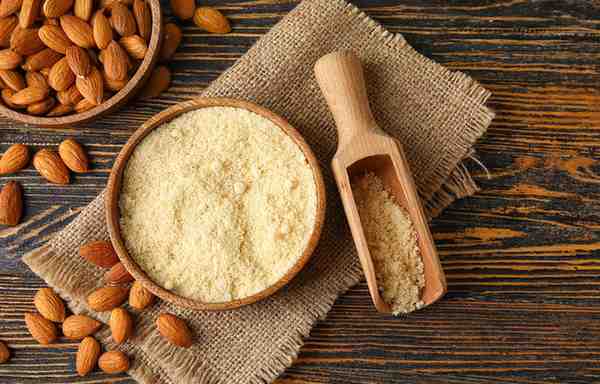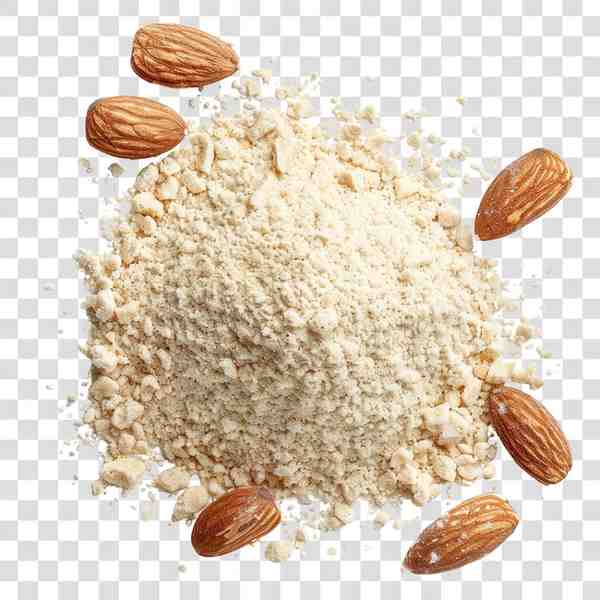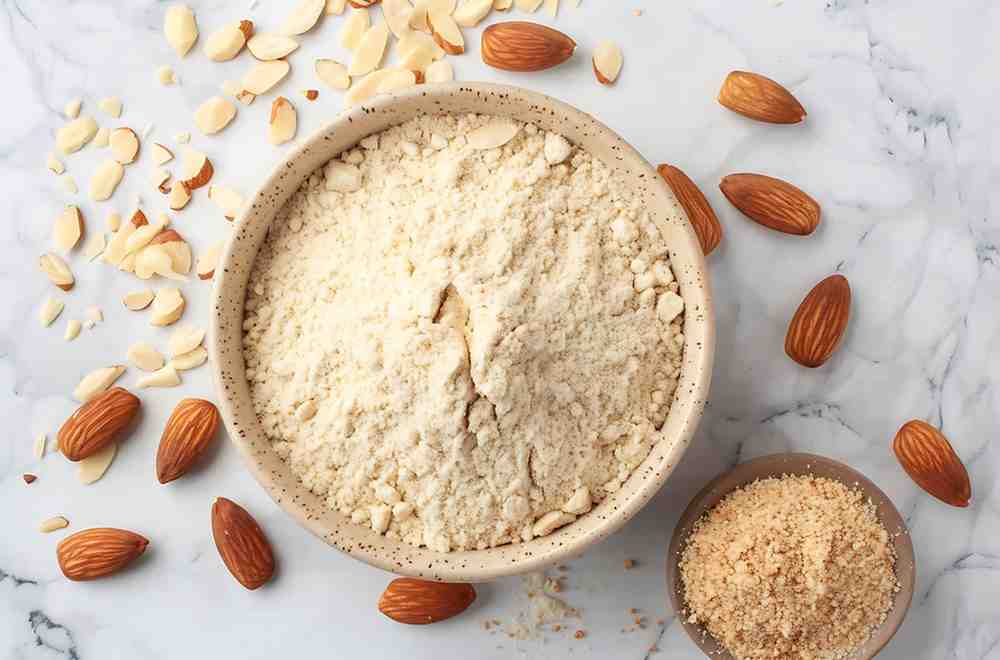Almond flour and almond meal are widely used in kitchens across the globe, especially by those following keto or vegan diets. These gluten-free, nutritious alternatives to wheat flour are incredibly versatile. If you’re curious about their differences, culinary uses, and how to incorporate them into your keto or vegan lifestyle, this guide covers it all.
Introduction to Almond Flour and Almond Meal
Almond flour and almond meal might seem similar, but they have distinct differences that can affect your recipes. Let’s clarify their differences to enhance your cooking experience.
What is Almond Flour?
- Made from blanched almonds (skins removed).
- Ground into a fine, soft texture.
- Commonly used in baking, adding a light, tender quality to dishes.
What is Almond Meal?
- Made from whole almonds (skins included).
- Coarser texture than almond flour.
- Ideal for recipes that require more structure or texture, such as breading or dense baked goods.
Nutritional Benefits of Almond Flour for Keto and Vegan Diets
Almond flour is not just a gluten-free flour substitute, it is also packed with nutrients, making it perfect for keto and vegan diets.
Benefits for Keto Dieters
- Low in carbs: Almond flour contains only a fraction of the carbs found in traditional wheat flour, which helps maintain ketosis.
- Rich in healthy fats: It provides heart-healthy fats, essential for the high-fat, low-carb ketogenic diet.
- High in fiber: Supports digestion and helps you feel full for longer.
Benefits for Vegans
- High in protein: Almond flour offers a plant-based protein source, essential for vegan diets.
- Rich in vitamins and minerals: Contains vitamin E, magnesium, and calcium, promoting overall health.
- Great alternative to processed flours: Almond flour is minimally processed, which aligns with a clean eating vegan philosophy.
Culinary Uses of Almond Flour and Meal
The culinary uses of almond flour and meal are vast, ranging from savory dishes to sweet treats. Their flexibility makes them a go-to for many kitchen experiments.
Baking with Almond Flour
Almond flour’s fine texture makes it ideal for gluten-free baking. Here’s how you can use it in your kitchen:
- Perfect for cakes, muffins, and cookies: Almond flour produces moist, tender baked goods: Keto Tart Tatin, Keto Chocolate Ganache Tart, and Keto Lemon Tart.
- Tips for baking:
- Use additional eggs for better binding and structure.
- Reduce liquid in recipes, as almond flour absorbs more moisture.
Using Almond Flour in Savory Dishes
In addition to sweets, almond flour excels in savory applications:
- As a coating: Use it to coat chicken, fish, or vegetables before frying or baking.
- As a thickener: Perfect for adding texture and thickness to soups and sauces.
- In pizza crusts: Almond flour’s richness makes it a perfect base for low-carb, keto-friendly pizza crusts.
Breadcrumb Substitute
Almond meal works well as a substitute for traditional breadcrumbs:
- Great for meatballs and casseroles: Adds flavor and binds ingredients together.
- Low-carb option for breading: Ideal for frying foods while keeping them keto-compliant.

Keto-Specific Uses of Almond Flour
For those following a keto diet, almond flour is a versatile staple that can be incorporated into numerous dishes. Here are some keto-friendly ideas:
- Keto Almond Pancakes: Light and fluffy pancakes without the carb overload.
- Almond Flour Crackers: A crunchy, low-carb snack perfect for dipping.
- Low-Carb Bread: Almond flour is the base for many keto bread recipes, providing a delicious alternative to traditional bread.
Vegan-Specific Uses of Almond Flour
Almond flour also works exceptionally well in vegan dishes. Its naturally rich, nutty flavor enhances both sweet and savory recipes.
- Vegan Almond Flour Pancakes: Fluffy, plant-based pancakes that are free of dairy and eggs.
- Vegan Almond Flour Cookies: Almond flour adds texture and flavor, perfect for vegan cookies and brownies.
- Grain-Free Tortillas: Almond flour is an excellent alternative for grain-free, vegan tortillas, perfect for tacos and wraps.
Tips for Using Almond Flour Effectively
To get the best results when using almond flour, keep these tips in mind:
- Store it properly: Almond flour is prone to spoilage, so keep it in an airtight container in the fridge or freezer.
- Adjust liquid ratios: Because almond flour absorbs more moisture, be prepared to reduce the amount of liquid in your recipes.
- Watch your bake times: Almond flour browns more quickly than traditional flours, so lower the oven temperature slightly or reduce bake time.
Common Mistakes to Avoid When Using Almond Flour
While almond flour is easy to work with, there are a few common pitfalls that can affect your final dish. Here’s how to avoid them:
- Overbaking: Almond flour browns faster than traditional flour, so it’s important to reduce your baking time slightly to avoid burning.
- Not Adjusting Liquids: As almond flour absorbs more moisture, not adjusting the liquid content in your recipe can lead to dry or crumbly baked goods.
- Incorrect Storage: Almond flour can spoil quickly if not stored properly. Always keep it in an airtight container and store in the fridge or freezer for longer shelf life.
Advanced Culinary Tips for Working with Almond Flour
If you’re already familiar with almond flour basics, these advanced tips will take your cooking and baking to the next level.
Incorporating Almond Flour into Gluten-Free Breads
Almond flour is a fantastic base for gluten-free breads. Here’s how to achieve the best results:
- Use a mix of flours: Combine almond flour with other gluten-free flours like coconut flour or tapioca starch to achieve a more balanced texture.
- Add binding agents: Using xanthan gum, psyllium husk, or flaxseed meal can improve the structure of almond flour-based bread.
Enhancing Texture in Baked Goods
Because almond flour is rich in fat, it can produce denser baked goods. To balance this:
- Use egg whites: Adding egg whites to your recipe can help lighten the texture, particularly in cakes and muffins.
- Leavening agents: Ensure you’re using enough baking powder or baking soda to give your baked goods the necessary rise.
Making Almond Flour More Affordable
Almond flour can be more expensive than regular flours. Here are some ways to reduce costs:
- Make it at home: Simply grind blanched almonds in a food processor to create your own almond flour. Be sure to pulse slowly to avoid making almond butter.
- Buy in bulk: Purchase almond flour in bulk from wholesale suppliers or local markets to save money.

Keto-Specific Almond Flour Recipes
Almond flour is a hero ingredient in many keto recipes, thanks to its low carbohydrate content. Here are some must-try keto dishes:
- Keto Almond Flour Pizza Crust
- A crisp, low-carb alternative to traditional pizza crust.
- Top with your favorite keto-friendly toppings like cheese, vegetables, and meats.
- Keto Almond Flour Blondies
- Rich, chewy blondies made with almond flour and sweetened with a keto-approved sweetener like erythritol or monk fruit.
- Perfect for a low-carb dessert that doesn’t compromise on taste.
- Almond Flour Tortillas
- Soft and pliable, these keto tortillas are a perfect wrap substitute for tacos or burritos.
- Combine almond flour with eggs and water to create the dough, and cook in a skillet until lightly browned.
Vegan-Specific Almond Flour Recipes
Vegan bakers love almond flour for its rich flavor and the structure it provides in plant-based recipes. Here are some vegan-friendly almond flour recipes that will delight your taste buds:
- Vegan Almond Flour Pancakes
- Fluffy, plant-based pancakes without eggs or dairy.
- Substitute eggs with flax or chia seeds to create a binding effect and maintain moisture.
- Vegan Almond Flour Chocolate Chip Cookies
- Soft and chewy cookies that are 100% plant-based.
- Replace butter with coconut oil or vegan butter and use dairy-free chocolate chips.
- Vegan Almond Flour Brownies
- Dense, fudgy brownies that are completely dairy-free and egg-free.
- Use applesauce or mashed bananas as an egg substitute for moist, gooey brownies.
Frequently Asked Questions (FAQs) About Almond Flour
Here’s a look at some of the most commonly asked questions about almond flour, based on popular queries.
Is Almond Flour Gluten-Free?
Yes, almond flour is naturally gluten-free since it is made from ground almonds. It is an excellent alternative to wheat flour for those with celiac disease or gluten sensitivity.
Can I Substitute Almond Flour for All-Purpose Flour?
Not exactly. Almond flour and all-purpose flour have different properties. Almond flour is denser and more absorbent, so it typically requires adjustments to liquids and eggs in recipes. It’s best to follow recipes specifically developed for almond flour.
Is Almond Flour Safe for People with Nut Allergies?
No, almond flour is made from nuts, so it is not safe for individuals with nut allergies. Those with nut allergies should look for alternative gluten-free flours, such as coconut flour or oat flour.
How Should I Store Almond Flour?
Almond flour should be stored in an airtight container in the refrigerator or freezer to prevent it from becoming rancid. If stored properly, it can last up to six months in the refrigerator and even longer in the freezer.
What’s the Difference Between Blanched and Unblanched Almond Flour?
Blanched almond flour is made from almonds that have had their skins removed, resulting in a finer, lighter-colored flour. Unblanched almond flour includes the almond skins, giving it a coarser texture and darker color. Both can be used in recipes, but blanched almond flour is preferred for delicate baked goods.

